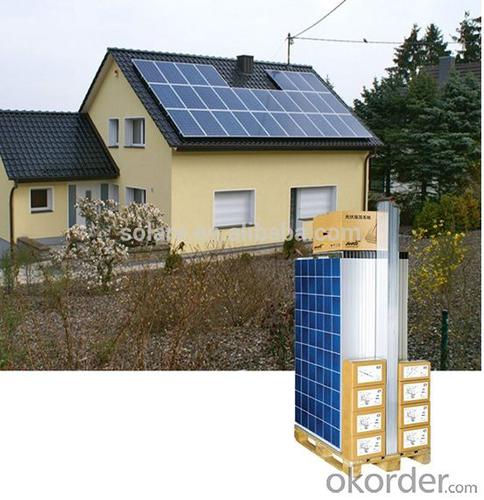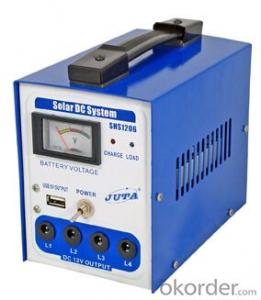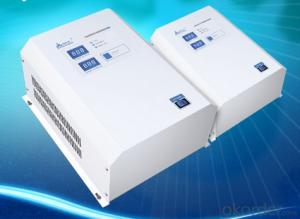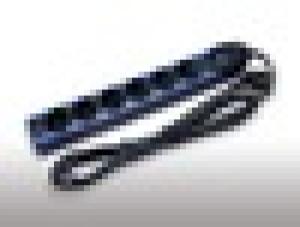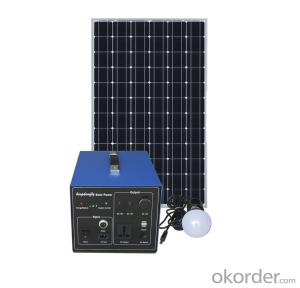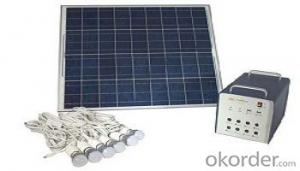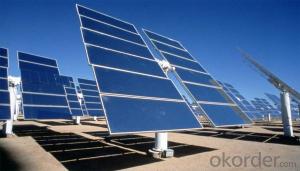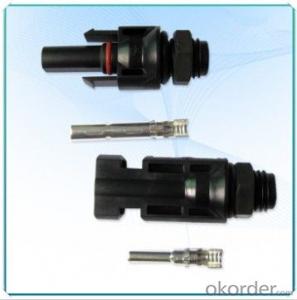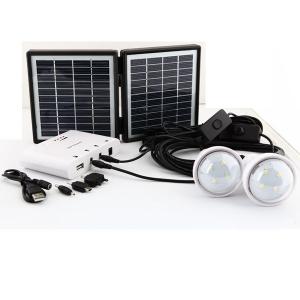Chennai Solar Energy Systems - 8kw Homeuse Grid Solar System without Battery
- Loading Port:
- Shanghai
- Payment Terms:
- TT or LC
- Min Order Qty:
- 8000 watt
- Supply Capability:
- 200000 watt/month
OKorder Service Pledge
OKorder Financial Service
You Might Also Like
Solar system advantages:
1. CE, ROHS approved.
2. High conversion efficiency, high-transmission rate.
3. Energy saving, environmental-friendly.
4. Advanced technology, strict quality control system.
5. Easy installation, safe operation, free maintenance.
6. Low MOQ, fast delivery time, long service life
| Quick Details | |||||
| Specification: | Normal | Application: | Home | Output Voltage (V): | 230~400V |
| Load Power (W): | 7800W | Solar Power (W): | 8000W | Work Time (h): | 10hours |
| Warranty: | 10years | Name: | grid solar system without battery | Model: | SLG-8KW |
| Max AC power: | 8000W | Max DC voltage: | 1000VDC | Max current: | 2*20A |
| MPPT Voltge range: | 300-800VDC | Max DC power: | 8250W | Inverter efficiency: | 98% |
| Solar panel model: | Poly solar panel 250W | ||||
| Packaging & Delivery | |
| Packaging Detail: | grid solar system without battery:Fullset system packed into cartons with pallets, 10sets can packed into 20'container, 22sets can packed into 40'container. |
| Delivery Detail: | 7-15days |
Specifications
grid solar system without battery
1)Good performance
2)High efficiency
3)Easy installation
4)Speical customs OEM
8KW homeuse grid solar system without battery
Product Description
Product Overviews:
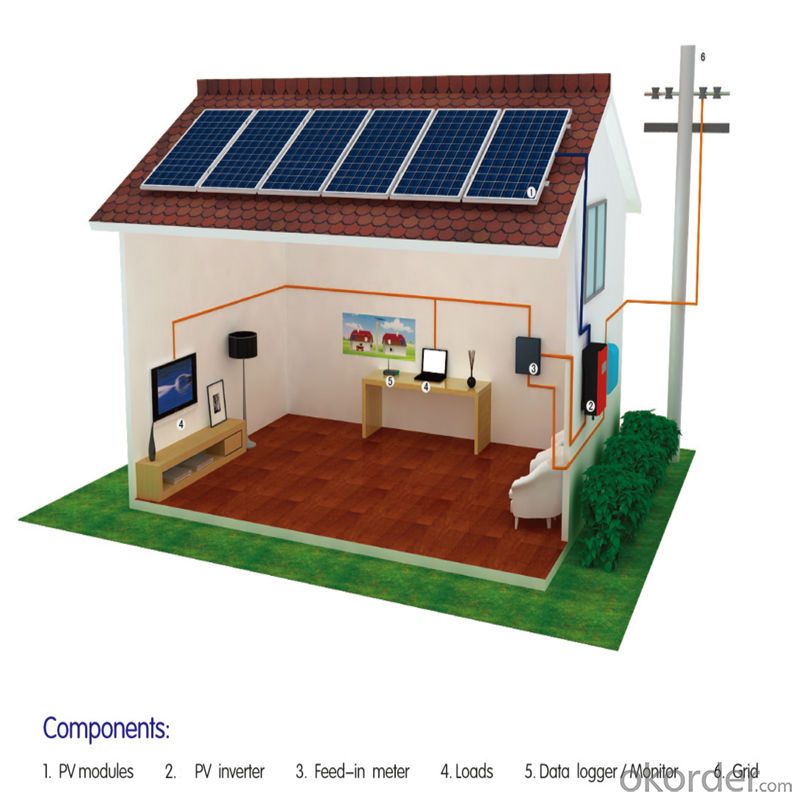
Product Parameters:
| Solar Panel / PV Module | |
| Module type | TSP-250W |
| Rated Power | 250Wp |
| Tolerance | 0-+3% |
| Open Circuit Voltage (Voc) | 36.58V |
| Short Circuit Current (Isc) | 9.15A |
| Max.Power Voltage (Vm) | 29.5V |
| Max.Power Current (Im) | 8.47A |
| Temperature coefficients of Isc (%) | 0.10/℃ |
| Temperature coefficients of Voc(%) | -0.33/℃ |
| Temperature coefficients of Pm(%) | -0.23/℃ |
| Cell efficiency(%) | ≥17.15% |
| FF(%) | 75% |
| Working Temperature Range | -40 to +85°C |
| Max Systsem Voltage | 1000V DC |
| Max Rated Fuse Current | 15A |
| Nominal operating cell temperature (NOCT): | 47°C |
| Solar cells | 6*10 polycrystalline Cells(156*156mm) |
| Size | 1640×990×40mm |
| Weight | 20Kg |
| The front cover glass | 3.2mm high transmittance,low iron,tempered glasses |
| Frame | Anodized aluminum |
| Juntion box | Protection class IP67 Rated |
| Cbles | Length:900mm, 1*4.0mm2 |
| Standard Testing Condition | 1000W/m², Cell temperature 25°C, AM1.5, Compliance with IEC61215 ,IEC61730-1 / 2 certification standards |
| PV Grid Inverter | |
| Model | Solartec D 8000 |
| Max DC Power | 8250W |
| Max DC Voltage | 1000V |
| System Start-up Voltage | 250V |
| Nominal DC Voltage | 650V |
| PV Voltage MPPT | 300v-800V |
| Max input Current | 2*16A |
| Max input short circuit current | 2*20A |
| Number of MPPT Trackers | 2 |
| Strings of each MPPT | A:1, B:1 |
| Nominal AC Output | 8000w |
| Nominal Grid Frequency Range | 50HZ |
| Max output current | 15A |
| THD of AC current | <3% |
| Nominal grid voltage range | 230-400V(3/N/PE) |
| Adjustable Displacement Factor | 0.9 overexcited…0.9underexcited |
| Number of feed-in phase | three-phase |
| Max efficiency | 98.00% |
| Euro efficiency | 97.30% |
| Mounting Method | Wall bracket |
| Reverse Polarity Protection | Short-CircuitDiode |
| DC Switch | Integrated |
| Short-Circuit Proof | Yes |
| Grid monitoring | Yes |
| Display | LCD |
| Accessory interfaces | RS485/RS232/WIFI |
| Standard Warranty | 5years |
PV Mounting Sysstem
Material is galvanized steel or aluminum,
According to different roof and installation address , have many types for choice.
Benefits of Solar Power:
Now is a great time to go solar and harvest the power of the sun. Here is our top ten list of the benefits to installing solar power:
1, When installed, solar energy is free – no resources are consumed
2, Help to lessen our dependence on heavily polluting coal power stations
3, Fossil fuels can't last forever, future generations will appreciate the effort
4, You are gaining energy independence - add battery backup power for even greater energy security
5, The cost of electricity is only going to rise – insure against that rising cost
6, Quality solar power and water adds value and appeal to your home
7, Solar PV systems are easily upgraded in future - aim to make your house a net energy producer!
8, Solar panels offer a long lifetime of low maintenance service, maybe 30-40 years
9, Your friends will think you're great!
10, You'll feel great for doing your bit for the environment!
- Q: What is a solar inverter and why is it necessary?
- A solar inverter is an essential device in a solar power system that converts the direct current (DC) generated by solar panels into alternating current (AC) electricity suitable for powering household appliances and feeding into the electrical grid. It is necessary because most household appliances and the electrical grid operate on AC power, while solar panels produce DC power. Without a solar inverter, the generated solar energy would be unusable and incompatible with our existing electrical infrastructure. Therefore, a solar inverter plays a vital role in enabling the efficient utilization of solar energy and facilitating its integration into our daily lives.
- Q: What is the maintenance schedule for a solar energy system?
- The maintenance schedule for a solar energy system typically involves regular inspections and cleanings to ensure optimal performance. Additionally, it is recommended to check the system's components, such as inverters, wiring, and batteries, for any signs of wear or malfunction. The frequency of maintenance depends on various factors, including the location, climate, and type of system. Generally, it is advised to have a professional inspection at least once a year, but regular self-monitoring and cleaning can help maintain the system's efficiency and longevity.
- Q: Can a solar energy system be installed on a boat or RV?
- Yes, a solar energy system can be installed on a boat or RV. In fact, it is becoming increasingly common for boat and RV owners to install solar panels to power their electrical systems. Solar panels can be mounted on the roof or deck of the boat or RV, or they can be portable and set up when needed. These panels harness sunlight and convert it into electricity, which can be used to charge batteries, power appliances, and run various electrical devices. Installing a solar energy system on a boat or RV offers several benefits, such as reducing reliance on traditional fuel sources, providing a sustainable and renewable energy option, and allowing for greater freedom and flexibility in remote locations where access to electricity may be limited. Additionally, solar panels are lightweight, durable, and low maintenance, making them well-suited for the mobile nature of boats and RVs.
- Q: Can solar energy systems be connected to the existing power grid?
- Solar energy systems can indeed be linked to the current power grid, known as grid-tied or grid-connected solar systems. In this configuration, solar panels harness sunlight to generate electricity, which is then converted by inverters into usable AC power. This AC power is then integrated into the existing power grid, effectively supplementing the utility company's electricity supply. Grid-tied solar systems provide multiple advantages. Primarily, they allow homeowners and businesses to decrease their dependence on fossil fuel-based electricity and reduce their carbon footprint. Moreover, any surplus electricity generated by the solar panels can be returned to the grid, resulting in net metering or feed-in tariffs. In this scenario, the excess power is credited to the system owner by the utility company, leading to substantial cost savings or even potential revenue generation. Furthermore, grid-tied systems ensure a reliable and consistent supply of electricity. During periods when the solar panels are unable to generate sufficient power, such as at night or during cloudy weather, electricity can be acquired from the grid. Conversely, when the panels produce more electricity than is being utilized, the surplus is sent back to the grid, guaranteeing an uninterrupted and continuous power supply. It is important to acknowledge that the installation and connection of grid-tied solar systems may necessitate the approval and coordination of the local utility company, as well as adherence to pertinent regulations and safety standards. Nevertheless, the capability to connect solar energy systems to the existing power grid renders them a versatile and advantageous renewable energy solution.
- Q: Are there any tax credits available for installing a solar energy system?
- Yes, there are tax credits available for installing a solar energy system. The federal government offers a Solar Investment Tax Credit (ITC) which allows homeowners and businesses to deduct a percentage of the cost of installing a solar energy system from their federal taxes. As of 2021, the ITC offers a 26% tax credit for systems installed through the end of 2022. However, it is important to note that the tax credit will decrease to 22% in 2023 and will only apply to commercial installations. Additionally, some states also offer their own tax incentives for solar energy systems, such as tax credits, rebates, or exemptions. It is recommended to check with your state or local government to determine if there are any specific tax credits available in your area.
- Q: What is net metering?
- Net metering is a billing arrangement that allows residential and commercial customers with solar panels or other renewable energy systems to receive credit for any excess electricity they generate and send back to the grid.
- Q: How does net metering work with solar energy systems?
- Net metering is a billing arrangement that allows solar energy system owners to receive credits or compensation for the excess electricity they generate and feed back into the grid. When a solar energy system produces more electricity than is being consumed on-site, the surplus power is sent back to the utility grid. In return, the utility company credits the system owner's account for the excess electricity, which can be used to offset future electricity consumption from the grid, effectively "spinning the meter backward." This arrangement enables solar energy system owners to save money on their utility bills and encourages the adoption of renewable energy by providing financial incentives.
- Q: Do solar energy systems require maintenance?
- Yes, solar energy systems do require maintenance. Regular maintenance, such as cleaning the panels, checking for any damage or malfunctions, and ensuring proper functioning of the system, is necessary to maintain the efficiency and longevity of the solar energy system. Additionally, periodic inspections by professionals can help identify and address any potential issues before they become major problems.
- Q: Can solar energy systems be used in powering car charging stations?
- Yes, solar energy systems can be used to power car charging stations. Solar panels can be installed on the roof or nearby areas to generate electricity from sunlight, which can then be used to charge electric vehicles. This renewable energy source helps reduce dependence on fossil fuels and lowers carbon emissions associated with transportation.
- Q: Can solar energy systems be used in areas with high levels of dust or sand?
- Solar energy systems can still function in dusty or sandy areas, although their efficiency may suffer. Dust or sand can gather on the surface of the panels, limiting the amount of sunlight that reaches the photovoltaic cells. Consequently, the system's energy production may decline. To address this issue, regular cleaning and maintenance of the solar panels are necessary in dusty or sandy regions. This can involve rinsing the panels with water or utilizing automated cleaning systems. Additionally, adjusting the tilt angles of the panels can minimize the accumulation of dust or sand. Moreover, advancements in solar panel technology have led to the creation of self-cleaning panels that repel dust or sand particles. These panels employ hydrophobic coatings or anti-soiling technologies to prevent dust buildup and maintain optimal energy production. In conclusion, although solar energy systems can operate in areas with high levels of dust or sand, it is crucial to implement appropriate maintenance and cleaning practices to ensure maximum efficiency and energy production.
Send your message to us
Chennai Solar Energy Systems - 8kw Homeuse Grid Solar System without Battery
- Loading Port:
- Shanghai
- Payment Terms:
- TT or LC
- Min Order Qty:
- 8000 watt
- Supply Capability:
- 200000 watt/month
OKorder Service Pledge
OKorder Financial Service
Similar products
Hot products
Hot Searches
Related keywords



